
![]() .Events .Moon .Planets .Minor Planets, NEOs .Comets .Shooting Stars .Occultations .Sun .check more! (occultations observers are advised to check in 'Events', and to turn to such dedicated sites like the I.O.T.A).
.Events .Moon .Planets .Minor Planets, NEOs .Comets .Shooting Stars .Occultations .Sun .check more! (occultations observers are advised to check in 'Events', and to turn to such dedicated sites like the I.O.T.A). ![]() Caution! According to our policy, our site is passing now DST for the southern hemisphere check more details. don't forget to check the weather! For the US: the NOAA . color codes: Wwd worldwide, UsA USA-Americas, EuA Europe-Africa, AsP Asia-Pacific, Chk Check for Your Zone. check the site's concept and the instructions of use
Caution! According to our policy, our site is passing now DST for the southern hemisphere check more details. don't forget to check the weather! For the US: the NOAA . color codes: Wwd worldwide, UsA USA-Americas, EuA Europe-Africa, AsP Asia-Pacific, Chk Check for Your Zone. check the site's concept and the instructions of use
![]()
 Editor's Choice Fine Picture
Editor's Choice Fine Picture ![]() Editor's Choice Sky At
Editor's Choice Sky At ![]()
![]()
![]() Tech News
Tech News ![]() color codes: Wwd worldwide, UsA USA-Americas, EuA Europe-Africa, AsP Asia-Pacific, Chk Check for Your Zone. check the site's concept and the instructions of use
color codes: Wwd worldwide, UsA USA-Americas, EuA Europe-Africa, AsP Asia-Pacific, Chk Check for Your Zone. check the site's concept and the instructions of use
| Tweet |
.Events Seen All Month Long .Ephemerides Proper
(data from yearly ephemerides generator at Fred Espenak's NASA's eclipse website; miscellaneous data with the 'Astronomical Phenomena for The Year 2017,' a joint work by the United Kingdom Hydrographic Office and the U.S. Naval Observatory; to be found at the latter's site; all time UT except otherwise stated)
Wwd Venus and Mars, where available like morning stars, are balletting by morning dawn during the month's first halvewith a closest reached about October 6th. Fine visual and photographic opportunities as the Moon may come to add
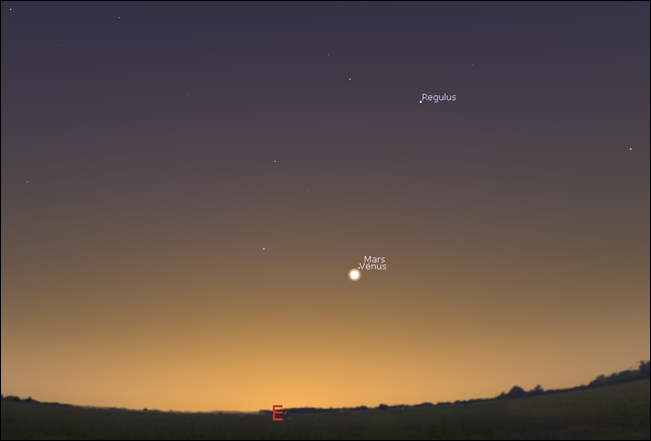 | Venus and Mars balletting by dawn! picture site 'Amateur Astronomy' based upon Stellarium |
Wwd Arcturus, the bright star to constellation Boötes, the Herdsman, constitutes a evening star in the northern hemisphere, about West
Wwd In the northern hemisphere, the Great Winter Sky is seen South by dawn. Fine visual and photographic opportunities as the Moon will also come to add!
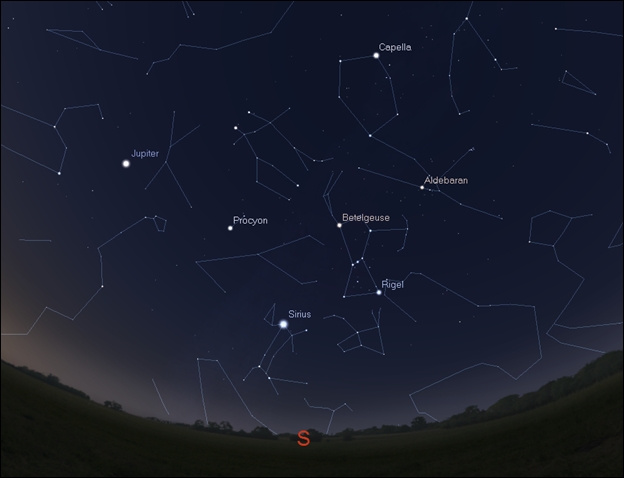 | The Great Winter Sky is seen South by dawn in the northern hemisphere! picture site 'Amateur Astronomy' based upon Stellarium |
2 (1) Wwd The Orionids shooting stars are usually active October 2nd-November 7th, with their peak usually on Oct. 21-22 more at the date of the peak
2 (2) Wwd Moon is at a descending node at 02:05 UT
3 Wwd Neptune is occulted by Moon by 12:00 UT! check more at such sites like "The International Occultation Timing Association" (I.O.T.A.); check too below
9 (1) Wwd Aldebaran, the bright star to constellation Taurus, the Bull is occulted by Moon by 19:00 UT! check more at such sites like "The International Occultation Timing Association" (I.O.T.A.); check too below
9 (2) Wwd Moon is at its perigee at 05:51 UT (distances non available)
11 Wwd Moon reaches a northernmost declination at 18:21 UT
14 Wwd Moon is at a ascending node at 22:10 UT
15 Wwd Regulus, the bright star to constellation Lion, the Lion is occulted by Moon by 11:00 UT! check more at such sites like "The International Occultation Timing Association" (I.O.T.A.); check too below
16 UsA EuA Tomorrow morning by dawn, at all latitudes, last crescent, where Mars and Venus available like morning stars, is seen close to Mars as Venus is close and the show is the reverse the following morning. Fine visual and photographic opportunities!
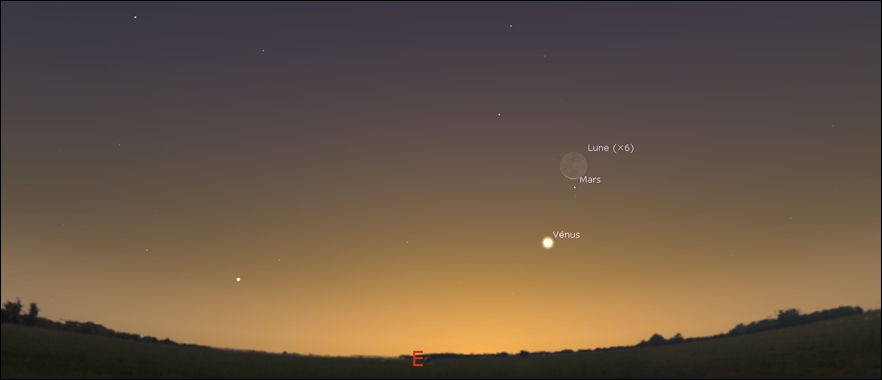 | Last crescent close to Mars and Venus by dawn! picture site 'Amateur Astronomy' based upon Stellarium |
17 AsP Tomorrow morning by dawn, by all latitudes, last crescent, where Mars and Venus available like morning stars, is seen close to Venus as Mars is close. Fine visual and photographic opportunities!
21 Wwd The Orionids shooting stars usually are peaking on Oct. 21-22more back
24 Wwd First crescent by all latitudes, is seen close to Saturn in twilight!
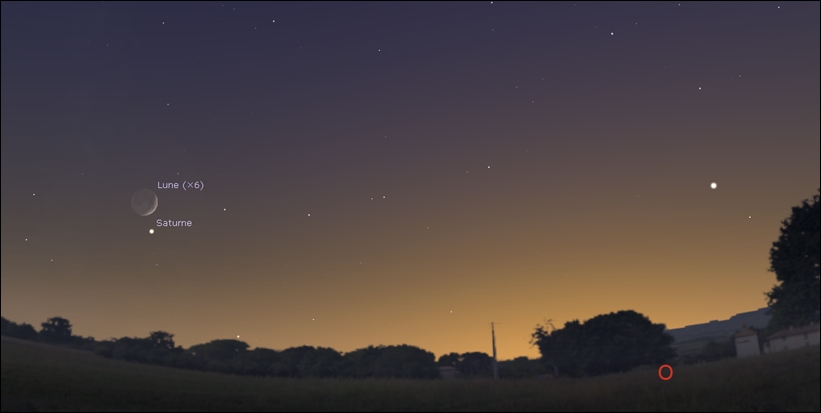 | First crescent seen close to Saturn by twilight! picture site 'Amateur Astronomy' based upon Stellarium |
25 Wwd Moon is at its apogee at 02:25 UT (distances non available) as it also is reaching a southernmost declination at 18:13 UT
29 Wwd Moon is at a descending node at 06:41 UT
30 Wwd Neptune is occulted by Moon by 21:00 UT! check more at such sites like "The International Occultation Timing Association" (I.O.T.A.); check too below
Occultations observers are advised to turn to such dedicated sites like the I.O.T.A as they may also check below at our Occultation section
Full Moon is on October 5th, at 18:40 UT
Last Quarter is on October 12th, at 12:25 UT
New Moon is on October 19th, at 19:12 UT
First Quarter is on October 27th, at 22:22 UT
(source: ephemeris generator at Fred Espenak's NASA's eclipse website)
Mercury is reaching a superior conjunction on October 8th, at 20:33. The swift planet is transitioning to turn a evening star as it keeps too low everywhere worldwide to be seen
Venus albeit it turned down somehow, keeps a fine morning star in the northern hemisphere. The same at the Tropics as Venus has now turned to the horizon in the southern hemisphere and no more observable
Mars has now turned a fine morning star worldwide, except in the southern hemisphere where it keeps low above the eastern horizon
Jupiter is reaching its conjunction on October 26th, by 18:02. check more about such a configuration of a planet in our tutorial 'Planets Apparent Motion'. With such a configuration, the gas giant is nowhere observable worldwide
Saturn is now a fine evening star in the northern hemisphere, before southwest as it is high, if qualified such, at the Tropics. About the same in the southern hemisphere, with Saturn still keeping high by 10:30 p.m. local time. A ring maximum aperture is reached in 2017
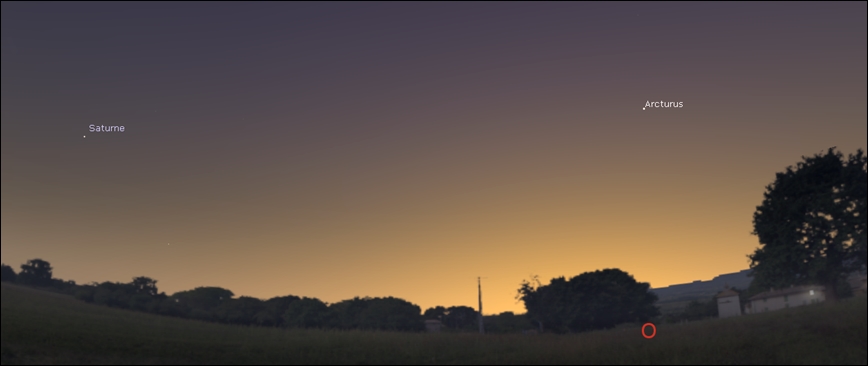 | Saturn a fine evening star! picture site 'Amateur Astronomy' based upon Stellarium |
Uranus Faraway World At its Best Now! is reaching its year's best now, with its opposition on October 19th, by 17:24. check more about such a configuration of a planet in our tutorial 'Planets Apparent Motion'. Uranus is now high in the northern hemisphere by 10:30 p.m. local time, between East and southeast and much high, past East by that time at the Tropics. Uranus, by 10:30 p.m. local time, is high, before northeast, in the southern hemisphere
 | Uranus reaching its opposition! picture site 'Amateur Astronomy' based upon Celestia |
Neptune Faraway World Still At its Best! keeps at its year's best after its opposition last month. Neptune is now due South, high, by 10:30 p.m. local time in the northern hemisphere as the faraway world is about the zenith by that time in the Tropics and lower, due North, by that time in the southern hemisphere
| Neptune keeping at its year's best! picture site 'Amateur Astronomy' based upon Celestia |
Pluto now is tending low southwest by 10:30 p.m. local time in the northern hemisphere as it keeps sufficiently high for observation at the Tropics. Pluto remains high in the southern hemisphere (according to the International Astronomical Union (IAU) since 2006, Pluto is not considered a planet anymore, but categorized like a dwarf planet instead along with Ceres, Eris, Makemake, and Haumea, and the prototype of a new category of 'trans-Neptunian', 'Pluto-class' objects)
Minor planets are those biggest asteroids in the Asteroid Belt which may be easily observed by amateurs from the Earth, namely Ceres, Pallas, Juno, and Vesta (due to the new categorization by the International Astronomical Union (IAU) by 2006, Ceres belongs to the 5 dwarf planets in the solar system with Pluto, Eris, Makemake, and Haumea). check data and charts at our section Minor Planets on the yearly Calendar page as our tutorial 'Asteroids and Asteroid Hunting' is of help too. Any remarkable event linked to a minor planet may have a notice here below
Pallas is reaching its opposition on October 29th, 2017, at the 8.2th magnitude. more about Pallas in 2017 at our "Minor Planets in 2017"
Some small asteroids dubbed Near-Earth Objects (NEOs) are regularly making close approaches at Earth. People interested in such close approaches may obtain recent and upcoming data at NASA site Near-Earth Object Program (their section "Close Approaches"). Date, miss distance in AU or Lunar Distance (LD), estimated diameter, and relative velocity are available. For further observational purposes, check at the Near-Earth Object Program ephemeris Generator. For more about NEOs see tutorial "
Once every time, the solar system treats us with a remarkable comet, a eery view spanning up to thirty degrees of sky! Most of the time however comets are the domain of dedicated observers as mostly weak and, at the most, hovering at the limit of the naked-eye visibility. A good site to get information about current such comets is the British Astronomical Association Comet Section page or also the Weekly Information about Bright Comets page (which often points to comets close to the visual magnitude). Our 'Comets and Comet Hunting' tutorial will also be helpful. Remarkable comets otherwise usually will be presented below!
->of note: dates of swarms and peaks as given below are the average ones. More refined dates may be given in the Ephemerids section
->note: shooting stars afficionados will be aware of checking Moon at the dates of the showers
for more about the meteor showers of this month, for possible other meteor showers for this month, and for more about shooting stars, generally, see our tutorial "Shooting Stars"
Each month, Moon occults some relatively bright stars, that is the Moon, beginning either with its bright or its dark visible face, is passing in front of a star. This is called an occultation. The Pleiades, on the other hand, due to their position near the eclipic, are often occulted by Moon too. Some planets, at last, along the year, may be occulted by Moon or they themselves, or their satellites, may be seen too occulting a star. The asteroids too may occult stars. Yearly lists of such phenomenons are to be found at Sky & Telescope/SkyTonight.com, either in their newsstand issues or at their site, as a list of occultations of most brilliant stars, the planets and the Pleiades are available at the I.O.T.A site (I.O.T.A. stands for "The International Occultation Timing Association"). Most notable occultations are signaled below
Neptune back is occulted by Moon on October 3rd by 12:00 UT! The show is available in the Kerguelen Is., most of Antarctica, S.E. tip of Australia, New Zealand, and S.W. Polynesia. check more at such sites like "The International Occultation Timing Association" (I.O.T.A.)
Aldebaran back, the bright star to constellation Taurus, the Bull is occulted by Moon on October 9th by 19:00 UT! The show is available in Central and N.E Asia, Alaska, and N.W. Canada. check more at such sites like "The International Occultation Timing Association" (I.O.T.A.)
Regulus back, the bright star to constellation Leo, the Lion is occulted by Moon on October 15th by 11:00 UT! The show is available in N. America except Canada, most of Caribbean, Cape Verde, and W. Africa. check more at such sites like "The International Occultation Timing Association" (I.O.T.A.)
Neptune back is occulted by Moon on October 30th by 21:00 UT! The show is available in most of Antarctica and the S. tip of Africa. check more at such sites like "The International Occultation Timing Association" (I.O.T.A.)
Faraway Neptune back is occulted by Moon by 06:00.3 UT as the show is mostly observable in a small area of the Russian far east only! check more at such sites like "The International Occultation Timing Association" (I.O.T.A.)
check on this site for more about occultations, theoretically
| CAUTION! OBSERVING THE SUN IS DANGEROUS AND REQUIRES DEDICATED SAFE TECHNIQUES! |